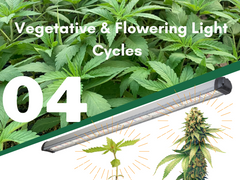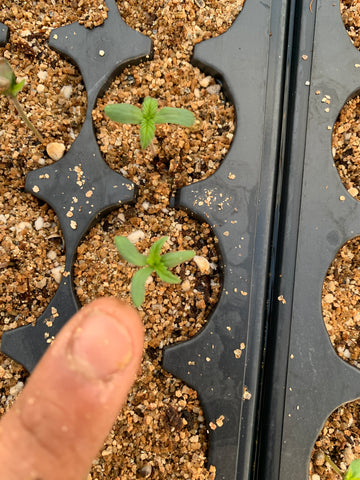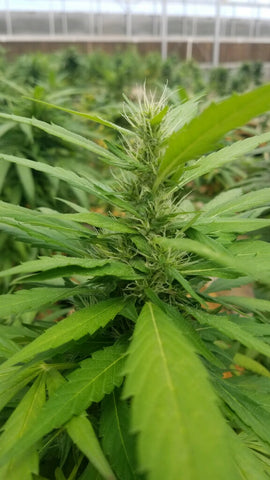
If you have the system for it. That means either supplemental lighting to hold plants in the vegetative cycle or complete light deprivation tents to stimulate plants into a flowering cycle, it’s a great idea to separate your vegetative growing from your flowering growing when cultivating your commercial cannabis crop. If you are strictly outdoors controlling your light cycle will be completely out of your control and dictated by the summer and winter solstice. That doesn’t mean that you cannot have a mother plant but rather it will not be cost effective to try and keep your outdoor plants mothered during the winter months if you do not have the infrastructure that will allow for that to happen.
Regardless you can divide these two aspects of your grow in an indoor or greenhouse setting, it can be easier to keep your “mother” plants alive in the vegetative state in a separate area indefinitely and more efficient to keep your “perpetual” flowering and harvest cycle going in another separate area This will allow you to better maintain your cloning ability, keep your crop rotation and always have vegetative plants prepared for your 5 harvests annually.
Outdoors when day lengths shorten in the northern hemisphere, the critical photoperiod in cannabis which initiates the change from vegetative growth (leaf production) to reproductive growth is occurring. The critical daylength trigger is between 14 and 14.5 hours of daylight but appears to vary by cultivar. That photoperiod shift normally occurs between 1 and 15 August in northern climates. Therefore, cuttings being taken for next year’s mother stock which are growing under natural light conditions need to be taken prior to advancement of the flowering cycle and when the summer daylight shifts to fall/winter.
Vegetative Cycle
Seeds Turn into Seedlings
All the energy needed to sprout and for your plant to begin its journey is within the seed you just need to present the ideal conditions to unlock that potential. To begin your vegetative cycle, you must either start with a clone or a seed. Germination is followed by root establishment, and then seedling development. Maintain 18 hours of light and 6 hours of complete darkness. During the beginning of your grow, you will need to keep a day temperature of 75 Fahrenheit and a night temperature 65 Fahrenheit.
If you overheat the seedlings, they will die so manage your temperatures diligently. You want to maintain a relative humidity (RH) of 80%. The soil or media you chose must have a pH in the range of 6.0-6.2 with porosity. SEEDLINGS DO NOT NEED NUTRIENTS DURING THIS STAGE. The EC must be a 0, rely exclusively on pre-charge. You can inoculate with rhizobacteria or mycorrhizal fungi at this time. The soil should be teeming with it.
You need to meticulously monitor the seedling moisture levels to ensure the young roots do not dry out. You want to ensure adequate air turnover and provide optimal heating and cooling with proper exhaust and air fans to avoid scorching or blistering the young tender leaves. High Pressure Sodium (HPS) lights are a culprit of doing this in greenhouse or indoor systems.
Seedlings Turn into Vegetative Plants
Vegetative rooms simulate the summer sun and have longer light periods to help young clones and prevents your “mother” plants from flowering. When you have your summer outdoor cycle in full swing it would be appropriate to start planning for the next stage of cutting sales in the spring. Cuttings should be taken around the beginning of August (if your plants are outdoors) and placed under the appropriate lighting conditions to ensure that they stay in the vegetative state.

You can take cuttings at any time in an indoor vegetative grow room, keep in mind you need at least 6-8 months to get mothers to the appropriate size for commercial clone cuttings, incorporate this into your system planning. This can be accomplished by extending the daylength to 16 to 18 hours or by a darkness interruption from 10 PM to 2 AM. No matter if a grower utilizes day extension or a night interruption it is imperative that plants do NOT experience a continual dark period which exceeds 9.5 hours and must continually feed and train the plants as they continue to grow more leaves, stems, and larger in size.
Flowering Cycle
Fruit from Photoperiod Shift
The flowering room can be left at 12 hours of light and 12 hours of darkness to induce flowering on only the plants ready to go.

In an indoor setting you want to keep your light source as close as possible to plants without overheating and burning leaves while still maintaining a higher dose of available nitrogen (N) since young plants still have to put on mass and size. Be prepared to water at least 2 liters of water if necessary. Duration of watering should allow 10-20% leaching out the bottom of the container to reduce the build-up of salts, especially if feeding additional nutrients. Maintain media pH of 6.0-6.2, E.C. of 1.2 mmhos/ cm, a relative humidity of 70%, a day temperature of 77 and night temperature of 65 °F. Continue CO2 at a 1600 ppm level and promote air movement via fans to slightly move the plants and stimulate healthy stress on the plants.
Ask any top grower today and they’ll tell you that separating their vegetative and flowering rooms are essential for keeping the grow going from one harvest to the next with no delays.
All it takes is the right setup, understanding of the demands of vegetative and flowering cycles and you’ll grow tastier buds and double your outcome with one simple step. The extra cost for high-quality clones or proven seeds will pay off when it comes time to harvest, and you’ve got the biggest, tastiest fruits in your grower’s circle.
If you missed Lesson 3: Relative Humidity & Temperature Dynamics click the link and refresh yourself on taking the first steps to creating more yields and optimizing your grow from the start.
Thanks for reading and please visit our shop to get started on your grow and stay social with us and reach out to our team if you have any questions about your soil and fertilizer needs.
Learn more about Comanche Compost Co. and stay up to date with other giveaways and cultivation pop up events around you!



